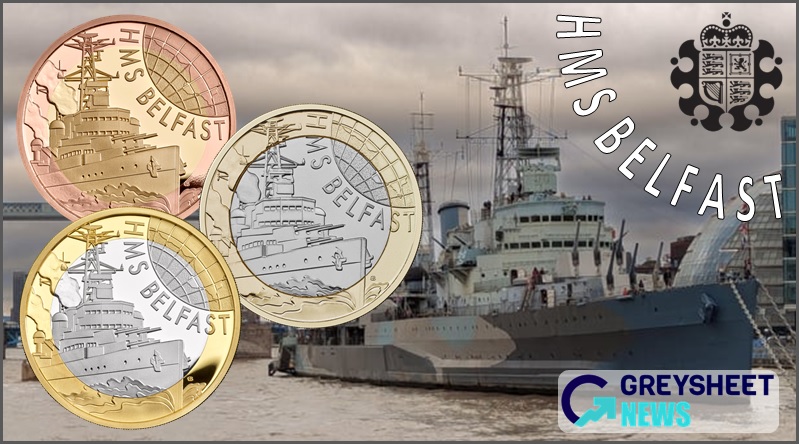The first UK coin of its kind to pay tribute to the legacy of this battle-hardened warrior, the formidable, imposing and resilient HMS Belfast found itself at the centre of some of the key moments of the Second World War. Of noteworthy missions was the sinking of the Scharnhorst in 1943 and the Normandy landings in 1944. An iconic vessel steeped in naval history, construction of HMS Belfast, the first ship in the Royal Navy to be named after the capital city of Northern Ireland and one of ten Town-class cruisers, began in December 1936. She was appropriately launched on St Patrick’s Day 1938 and commissioned in early August 1939 shortly before the outbreak of the Second World War, HMS Belfast was initially part of the British naval blockade against Germany and in November 1939, she triggered a German mine. As a result, there were fears that she would have to be scrapped but, the decision was made that the HMS Belfast would be repaired and spent more than two years undergoing extensive work. The HMS Belfast returned to action in November 1942 with improved firepower, radar equipment and armour which was soon deployed to carry out crucial action escorting Arctic convoys to the Soviet Union during 1943. In December 1943, she played an important role in the Battle of North Cape, assisting in the destruction of the German warship Scharnhorst, the lead ship of her class in the navy of the Third Reich.
Perhaps the most important deployment was in June 1944 when Belfast took part in Operation Overlord supporting the Normandy landings of allied forces. With the unconditional surrender of the Third Reich in May 1945, she was redeployed to the Far East in June to join the British Pacific Fleet, arriving shortly before the surrender of Imperial Japanese forces and the end of the Second World War in August. With the conclusion of World War II, HMS Belfast saw further combat action from 1950 – 1952 during the Korean War and afterward, she underwent an extensive modernisation between 1956 and 1959. A number of further overseas commissions followed before she entered reserve in 1963.
In 1967, efforts were initiated to preserve her as a museum ship and to aid this task, a joint committee of the Imperial War Museum, the National Maritime Museum, and the Ministry of Defence was established. In 1971, the formation of the private entity HMS Belfast Trust to campaign for her preservation was successful, and the government transferred the ship to the Trust in July 1971. Brought to London, she was moored on the River Thames near Tower Bridge and was officially opened to the public in October 1971. Now a part of the Imperial War Museum, the legendary British cruiser takes pride of place on the River Thames as London’s unique warship experience.
Designed by Gary Breeze, the reverse side features the iconic ship as it appeared in the 1960’s. To the upper left, a representation of a globe referencing the thousands of miles HMS Belfast travelled and was deployed during her 25 years of active service. Along the lower part of the globe is the text HMS BELFAST.
The obverse of each coin option features the definitive effigy of HM King Charles III designed by Martin Jennings. The denomination 2 POUNDS and year of issue 2025 also appears on the obverse as part of the legend surrounding the King’s likeness. Each coin includes an incused edge inscription in Latin which is the motto of the HMS Belfast and reads PRO · TANTO · QVID · RETRIBVAMVS which is translated as ‘For so much what shall we repay’
| Denomination | Metal | Weight | Diameter | Quality | Mintage limit |
| 2 Pounds | Bi-metallic | 12 g. | 28.4 mm. | BU | Unlimited |
| 2 Pounds | .925 Silver | 12 g. | 28.4 mm. | Proof | 3,510 |
| 2 Pounds | .925 Silver | 24 g. | 28.4 mm. | Proof | 1,948 |
| 2 Pounds | .9167 Gold | 15.98 g. | 28.4 mm. | Proof | 110 |
The BU bi-metallic base metal coins are housed in a blister-pak type folder with informative text and illustrations. The sterling silver proof and silver piedfort coins are presented in a custom black vinyl covered case and the gold proof coins are presented in a polished hardwood case – all are accompanied with a numbered certificate of authenticity. For additional information, please visit the e-webshop of the Royal Mint.


